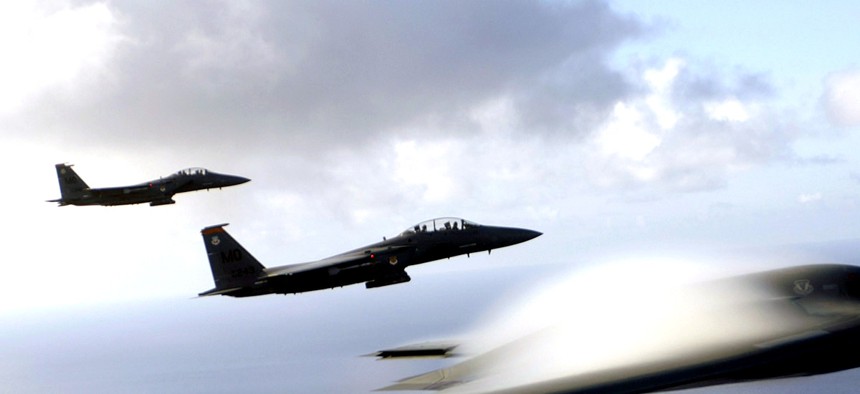
A B-2 Spirit and F-15 Strike Eagles fly in formation across the Pacific Ocean. Tech. Sgt. Cecilio Ricardo
New Air Force Bomber Is a Critical Piece of the Pentagon’s Pacific Weaponry
The Air Force’s new radar-evading nuclear bomber is the first large piece of weaponry being purchased with the Pentagon’s Pacific pivot in mind. By Marcus Weisgerber
WHITEMAN AIR FORCE BASE, Mo. – A new Air Force stealthy, nuclear-weapon carrying bomber is critical for deterring enemies and a vital piece of the Pentagon’s pivot to the Pacific region, Defense Secretary Chuck Hagel said Tuesday.
Money for the new program will appear in the Pentagon’s 2016 budget proposal that the Obama administration will send to Capitol Hill next month, the secretary said during a visit to Whiteman Air Force Base, the home of the Air Force’s fleet of 20 B-2 stealth bombers, the only long-range radar-evading planes ever built.
“I think the Long Range Strike Bomber is absolutely essential to keep our deterrent edge as we go into the next 25 years,” Hagel told a small group of reporters accompanying him on what is likely his last domestic trip as defense secretary. “It is critical … for the Asia-Pacific rebalance.”
This new aircraft would reassure allies and extends the reach of U.S. military strategic power, Hagel said.
“It’s something that I have particularly put a priority on [in] the budgets and things that I’ve talked about with the Congress,” he said. “I have confidence that the Congress will support us. It’s a critical element of our future long-range strategic deterrence capabilities.”
Later this year, the Air Force is expected to select either Northrop Grumman or a Boeing-Lockheed Martin team to build the new bomber. Pentagon leaders have said little about the project as it’s classified, with its details shrouded in secrecy.
The Air Force has had its eyes set on a new bomber for the past decade. The service had hoped to have a new aircraft battle ready by 2018, but the combination of a tight schedule for building sophisticated, unproven and expensive technology and politics over spending derailed the effort, sending the Air Force back to the drawing board.
(Related: The Air Force Is Losing Patience With Its Aging Bomber Fleet)
This time, planners pared back expectations, opting instead to build a bomber based on proven technology. Termed the Long-Range Strike Bomber and given the acronym LRS-B, the aircraft is a testament to its name. The plane must be able to fly long distances, undetected by enemy radar. It must be able to carry nuclear weapons and be flown with or without a pilot. And the price tag is capped at $500 million per jet.
The Air Force has said it would like to have the new bomber battle ready by the latter part of the 2020s. But funding uncertainty could make that difficult.
“I don’t see any barriers to that happening from a technical perspective and industrial base perspective,” said Mark Gunzinger, an analyst with the Center for Strategic and Budgetary Assessments and a former bomber pilot. “I do see problems with funding.”
Still, due to its high priority, Gunzinger believes the Pentagon and Air Force leadership will find the money to back the project, but possibly at the expense of other programs.
Air Force officials said they will control cost growth by using mature technology and systems already used on existing aircraft, something it did not do in the 1980s when building the B-2. At the time, the F-117 Nighthawk was the only radar-evading plane in existence and stealth technology was still in its infancy.
Cost growth on the B-2 was driven largely buy the significant truncation of the program. The Air Force once planned to buy 132 and then 75 Spirit bombers. In the end, it wound up with 21. That means when development is factored in, each aircraft cost $2.2 billion per copy.
“There was still a lot of invention with the B-2,” Gunzinger said. “That was the next-generation stealth aircraft, the F-117 was the first, and there was still a lot technology that needed to be developed to make it happen.”
While work progresses on the new bomber, the B-2 doesn’t appear to be going anywhere anytime soon as the Air Force plans to keep the plane around until the 2040s.
Although the B-2 it is the youngest bomber in the Air Force fleet, the 20-aircraft fleet still boasts an average age of 20 years. The boomerang-shaped flying wing was built in the 1980s.
When the U.S. dropped the first bombs in Afghanistan following the Sept. 11, 2001, attacks, B-2s flew 42-hour missions from Whiteman to Afghanistan and back without landing.
Up close, the aircraft has a smooth finish allowing it to fly without being detected by radar. Rigid antennas that oftentimes protrude from commercial jetliners are built into the skin of the aircraft.
Air Force maintainers – some less than 20 years old – who work on the small fleet spend an average 18 hours working on the skin for every one hour of flight, service officials said.
The aircraft have been modified over the years. Computers with the processing power of Commodore 64 personal computers of the 1980s have recently been replace by more modern machines. The aircraft have also received new radars.




